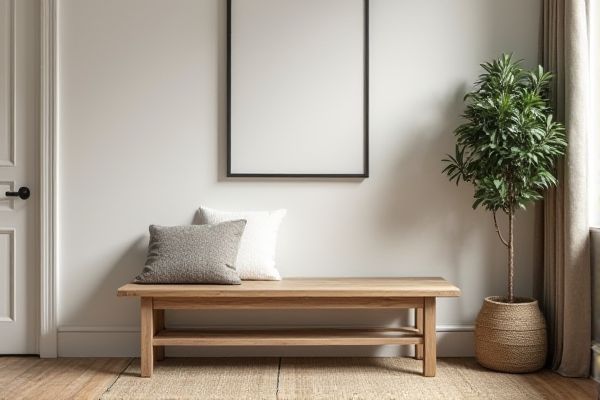
A backless bench offers a minimalist design that saves space and allows versatile seating arrangements, while a bench with back provides enhanced comfort and support for longer periods of sitting. Discover which option best suits your needs by reading the rest of the article.
Table of Comparison
| Feature | Backless Bench | Bench with Back |
|---|---|---|
| Comfort | Less support, may cause discomfort over time | Provides back support, more comfortable for long use |
| Design | Simple and minimalist, space-saving | More structured, often bulkier |
| Usage | Ideal for casual or short seating | Suitable for extended sitting and relaxation |
| Space Efficiency | Compact, fits in tight spaces easily | Requires more space due to backrest |
| Weight | Generally lighter and easier to move | Tends to be heavier and less portable |
| Aesthetic Flexibility | Versatile, suits various decor styles | Often more formal, may limit style options |
| Price Range | Often more affordable | Typically higher cost due to added materials |
Introduction to Bench Designs
Backless benches offer a minimalist design, promoting versatile seating arrangements ideal for open spaces and easy access from all sides. Benches with backs provide enhanced comfort and support, making them suitable for prolonged sitting in settings like dining areas or patios. Your choice depends on the balance between aesthetic preferences, functionality, and the intended use environment.
Overview of Backless Benches
Backless benches offer versatile seating options by providing an open design that fits well in various outdoor and indoor settings, allowing for easy access from multiple sides. These benches typically require less space and can serve multiple functions, such as doubling as a table or extra seating during gatherings. Your choice between backless benches and those with backs should consider comfort requirements and the intended usage environment.
Features of Benches with Backs
Benches with backs provide enhanced comfort and support, promoting better posture by supporting the spine. They are often designed with ergonomic features, including contoured backrests and armrests, making them suitable for extended seating in outdoor and indoor settings. These benches are ideal for public spaces, parks, and dining areas where comfort and durability are key considerations.
Ergonomic Considerations
A bench with back support provides better ergonomic benefits by promoting proper posture and reducing strain on your lower back during extended seating. In contrast, a backless bench encourages active sitting, which can strengthen core muscles but may lead to discomfort if used for prolonged periods without breaks. Choosing between the two depends on your specific needs for comfort, posture support, and duration of use.
Durability and Maintenance
Backless benches typically offer increased durability due to their simpler design and fewer components, reducing the risk of structural damage over time. Benches with backs may require more maintenance as the backrest creates additional stress points and can accumulate dirt or moisture, potentially leading to faster wear or damage. Both types benefit from materials like treated wood or metal to enhance longevity and minimize upkeep efforts.
Space and Placement Flexibility
Backless benches offer greater space and placement flexibility due to their compact design, allowing them to fit easily under tables or in narrow areas, maximizing floor space in small rooms. Benches with backs, while providing added comfort and support, require more room and careful placement to ensure clearance behind the backrest, limiting their adaptability in tight or irregular spaces. Choosing between the two depends on balancing the need for ergonomic seating against optimizing space efficiency in the intended environment.
Comfort Level Comparison
Backless benches offer a minimalist design but often provide less comfort for extended sitting since they lack back support, causing increased strain on your lower back and posture. Benches with backs deliver enhanced ergonomic support, making them ideal for longer periods of use by promoting proper spinal alignment and reducing discomfort. Choosing a bench with backrest significantly improves comfort level, especially for relaxation or dining areas where sitting duration is longer.
Aesthetic and Design Options
Backless benches offer minimalist aesthetics and versatility, seamlessly integrating into modern and open-concept spaces while allowing for double-sided seating arrangements. Benches with backs provide structured support and often serve as statement pieces with varied design elements like ornate carvings, upholstery choices, and high backs that enhance comfort and visual impact. Selecting between the two hinges on balancing space efficiency, stylistic coherence, and functional comfort in interior or outdoor settings.
Best Use Cases: Backless vs With Back
Backless benches are ideal for versatile seating arrangements in open spaces, allowing easy access from all sides and promoting social interaction in areas like patios or gardens. Benches with backs provide superior comfort and support, making them best suited for prolonged use in locations such as parks, dining areas, or waiting rooms. Your choice depends on whether you prioritize flexibility and space efficiency or ergonomic support and extended sitting comfort.
Conclusion: Choosing the Right Bench
Choosing the right bench depends on the intended use and space constraints; backless benches offer versatile seating and a minimalist aesthetic ideal for small areas or multi-purpose settings. Benches with backs provide enhanced comfort and support, making them suitable for longer seating durations in dining rooms or outdoor patios. Assessing factors like comfort needs, design preferences, and available space ensures the optimal bench selection for any environment.
 homyna.com
homyna.com